Bourbon vs Scotch: A Gentleman’s Debate
When it comes to fine spirits, few evoke as much passion and debate as bourbon and Scotch. These distinguished drinks have distinct characteristics, production processes, and cultural significance that set them apart. To fully appreciate these beverages, understanding their origins, ingredients, taste profiles, and drinking traditions is essential. Whether you lean towards the bold and rich flavors of bourbon or the complex and smoky notes of Scotch, exploring the nuances of each will deepen your appreciation for these iconic spirits.
Bourbon, a quintessential American whiskey, is known for its sweet and full-bodied flavors. It is made primarily from corn and aged in new charred oak barrels. On the other hand, Scotch, a whisky hailing from Scotland, offers a wide range of flavors, including peaty and smoky undertones. It is typically made from malted barley and aged in used oak barrels. Both spirits undergo distinct production processes that contribute to their unique qualities.

The geographical origins of bourbon and Scotch further differentiate the two. Bourbon is produced predominantly in the United States, with Kentucky being the most famous region for this spirit. On the other hand, Scotch whisky comes exclusively from Scotland, where the climate and terroir lend character to its production.
Taste and flavor profiles play a significant role in distinguishing bourbon from Scotch. Bourbon is often characterized by its rich, caramel, and vanilla notes, with variations offering hints of spice, fruit, and oak. In contrast, Scotch displays a wide range of flavors, from light and floral to heavily peated and smoky, with nuances of honey, heather, fruit, and malt.
Drinking culture and traditions surrounding bourbon and Scotch add to their allure. Bourbon is often enjoyed neat, on the rocks, or as the star ingredient in classic cocktails like the Old Fashioned or Mint Julep. Scotch, on the other hand, is commonly savored neat or with a few drops of water to unlock its complex flavors. It is also known for its esteemed status in celebrations and tastings, often paired with fine cigars.
Price and accessibility can also influence the choice between bourbon and Scotch. While bourbon tends to be more affordable than Scotch, prices can vary based on factors like age, brand, and rarity. On the other hand, Scotch whiskies may offer a wider range of options, from entry-level blends to rare and highly sought-after single malts.
In this article, we will delve into the fascinating world of bourbon and Scotch, exploring their production processes, ingredients, taste profiles, drinking traditions, and price considerations. By understanding the nuances of these spirits, you can navigate the nuanced debate between bourbon and Scotch and appreciate the craftsmanship and artistry that goes into each glass. Whether you prefer the boldness of bourbon or the complexity of Scotch, join us as we explore the characteristics that make each of these spirits a true gentleman’s choice.
Key Takeaways:
- Bourbon vs Scotch: A Gentleman’s Debate highlights the key differences between these two iconic beverages.
- Production processes differ: Bourbon is made primarily in the United States, while Scotch is made in Scotland, leading to distinct flavor profiles.
- Bourbon uses primarily corn, while Scotch uses barley, contributing to variations in taste.
Bourbon vs Scotch: A Gentleman’s Debate

Photo Credits: Www.Moderngentlemanmagazine.Com by Bryan Adams
When comparing Bourbon and Scotch, consider these factors:
- Taste: Bourbon has a rich and sweet flavor with notes of caramel, vanilla, and oak. Scotch offers a wider range of flavors, including peat, smoke, fruitiness, and spice.
- Production: Bourbon is made from corn and aged in charred oak barrels, giving it a distinct flavor. Scotch is typically made from malted barley and aged in various types of oak casks, resulting in unique characteristics.
- Geographical Indication: Bourbon is produced in the United States, while Scotch is produced in Scotland. This geographical distinction adds to the uniqueness and heritage of each spirit.
- Legal Requirements: Bourbon must have at least 51% corn in its mash bill and be aged in new charred oak barrels. Scotch must be aged for a minimum of three years in oak casks.
- Cultural Significance: Bourbon is deeply rooted in American culture, particularly in Kentucky and the bourbon trail. Scotch is closely tied to Scottish heritage and traditions.
Ultimately, the choice between Bourbon and Scotch depends on personal preference and the occasion. Whether you prefer the smooth richness of Bourbon or the diverse flavors of Scotch, both offer a refined and enjoyable drinking experience.
What is Bourbon?
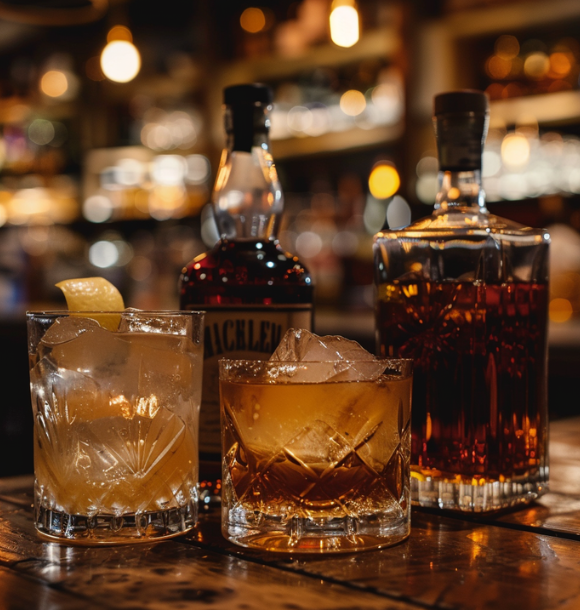
Bourbon is a whiskey known for its unique flavor and production process. So, what is bourbon exactly? It is made from a grain mixture of at least 51% corn, providing its signature sweetness and rich taste. Additional grains like barley, rye, and wheat are used in varying amounts to create different flavor profiles.
The production process involves distilling the grain mixture and aging it in charred oak barrels. These barrels contribute to the deep amber color and enhance the flavor as the bourbon matures. By law, bourbon must age for at least two years, though many premium bourbons age longer.
The geographical origin is important when discussing what is bourbon, as it can only be called bourbon if produced in the United States. Kentucky is particularly renowned for its bourbon production and is home to many top-quality brands.
So, now that you know what bourbon is, let’s talk about its taste. Bourbon has robust and complex flavors, often featuring notes of caramel, vanilla, and oak, with varying levels of sweetness and spiciness depending on the brand or style.
Understanding what bourbon is allows for an appreciation of its unique characteristics and informed choices when selecting a bottle. Bourbon offers a rich and flavorful experience for whiskey enthusiasts, whether enjoyed neat, on the rocks, or in a cocktail.
What is Scotch?

Scotch is a type of whiskey known for its rich flavor. What is Scotch? It is primarily made in Scotland, following strict regulations. Scotch is made from malted barley, water, and yeast, and aged in oak barrels for at least three years.
One characteristic of Scotch is its smoky and peaty flavor, which comes from the traditional malting process. The malted barley used in Scotch production is dried using peat, giving it a unique smoky aroma. This sets Scotch apart from other whiskeys.
Scotch comes in different varieties, including single malt Scotch and blended Scotch. Single malt Scotch is made from malted barley and produced at one distillery, while blended Scotch combines different malt and grain whiskies.
Traditionally, Scotch is enjoyed neat or on the rocks. Some Scotch enthusiasts may add a few drops of water to enhance the flavors and aromas. The drinking culture around Scotch is associated with sophistication and an appreciation for craftsmanship.
In terms of price and availability, Scotch can vary widely. There are affordable options, as well as premium and rare bottles that can be expensive. Scotch is widely available in liquor stores and bars worldwide for whiskey enthusiasts to enjoy.
Production Process
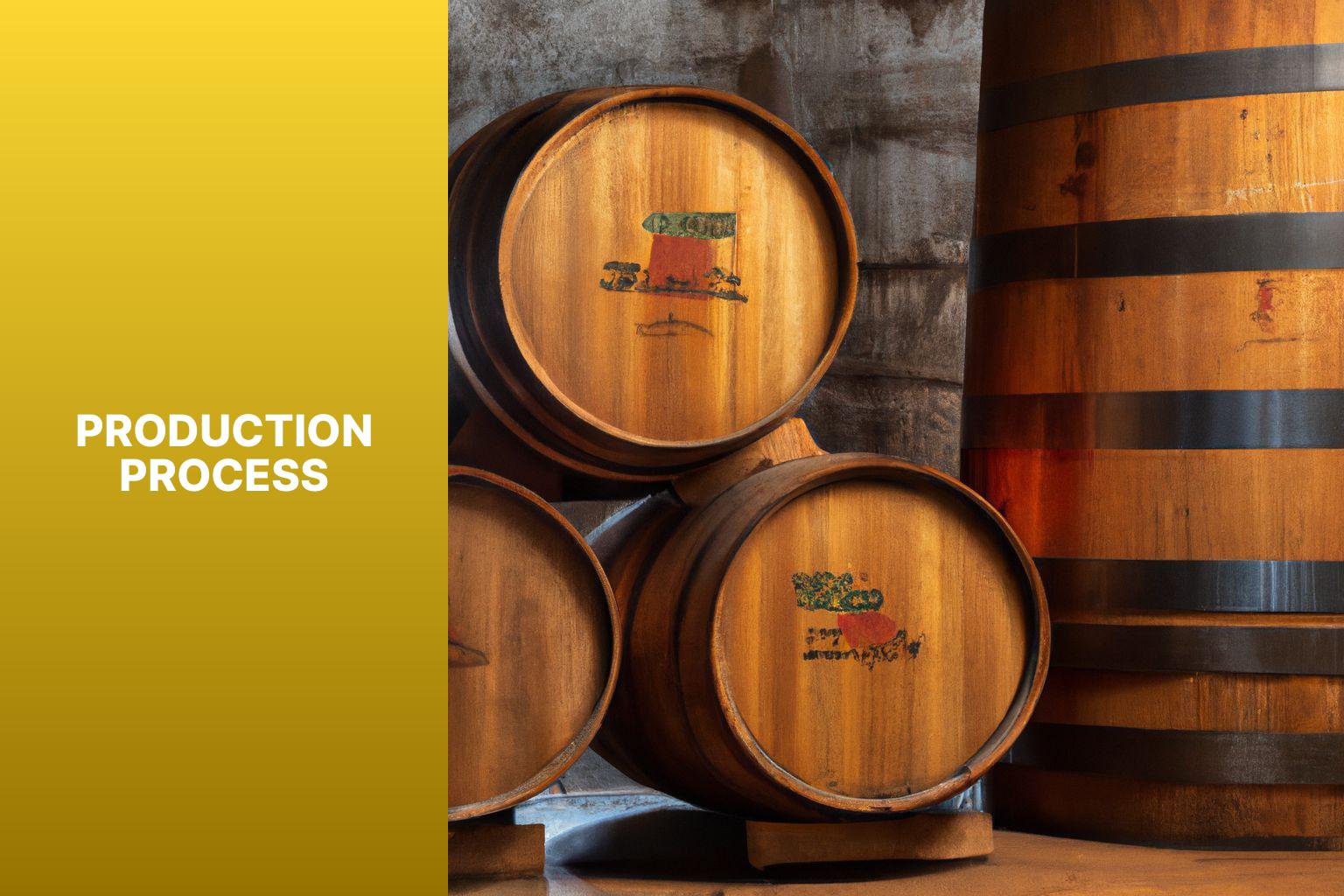
Photo Credits: Www.Moderngentlemanmagazine.Com by Randy Baker
The production process of bourbon and scotch involves several steps. This table compares the key differences between bourbon and scotch:
| Production Process | Bourbon | Scotch |
|---|---|---|
| Raw Materials | Mainly corn, with some rye and malted barley | Mainly malted barley, sometimes with other grains |
| Mashing | Grind, cook, and mix grain mixture with water | Grind grains, mix with water, and allow to ferment |
| Fermentation | Ferment mixture using yeast | Ferment mixture using yeast, usually in large wooden vats |
| Distillation | Distill in column stills | Distill in copper pot stills |
| Aging | Must age in new charred oak barrels for at least 2 years | Aged in used oak barrels for at least 3 years |
| Maturation | Further aging improves flavor and character | Continuing maturation in barrels until desired flavor is achieved |
This table provides a comparison of the production processes for bourbon and scotch. The differences in raw materials, mashing, fermentation, distillation, aging, and maturation contribute to the unique characteristics and flavors of each spirit. It’s important to note that bourbon must be made in the United States, while scotch is produced in Scotland. These distinct production processes are crucial in determining the final product and the taste profiles that bourbon and scotch enthusiasts appreciate. Understanding their production processes will help you select the spirit that aligns with your preferences and taste.
How is Bourbon Made?
Bourbon is made through a regulated process that involves several steps.
A mixture of grains, known as the mash, is created. This usually consists of at least 51% corn, with the remaining grains typically being barley, rye, or wheat. The grains are ground and mixed with water, creating a thick, porridge-like substance.
Next, yeast is added to the mash, beginning fermentation. The yeast consumes the sugars in the grains and converts them into alcohol. Fermentation can take a few days to a week, depending on the desired flavor.
After fermentation, the resulting mixture called the distiller’s beer is distilled in copper stills. This process involves heating the liquid and separating the alcohol from other compounds through evaporation and condensation. The high-proof spirit is collected and transferred to charred oak barrels for aging.
Bourbon must age in new charred oak barrels for a minimum of two years. During this process, the spirit gains color, flavor, and complexity from the wood. Temperature fluctuations within the barrel contribute to maturation.
Once the desired aging period is reached, the bourbon is filtered and diluted to achieve the desired proof. Water may be added at this stage to reduce alcohol content.
How is Scotch Made?
Scotch whisky is made through a meticulous, regulated process for quality and distinct flavor. Here’s how Scotch is made:
1. Barley is germinated and dried in a malting facility to stimulate enzymes that convert starches into fermentable sugars.
2. Malted barley is mixed with hot water to extract sugars, creating a sugary liquid called wort.
3. Wort is transferred to a fermentation vessel, where yeast is added. Yeast consumes sugars, producing alcohol and creating wash.
4. Wash is distilled twice in copper pot stills. The first distillation separates the liquid into low wines, and the second distillation produces new make spirit with higher alcohol content.
5. New make spirit is filled into oak casks, typically ex-bourbon barrels or sherry casks. It must age for a minimum of three years in Scotland to be legally called Scotch whisky.
6. After maturation, whisky is often blended with other Scotch whiskies to achieve a consistent flavor profile. It is then diluted to the desired alcohol content with pure spring water and bottled.
Making Scotch whisky involves careful attention to detail at each stage to develop flavors and characteristics. High-quality ingredients and traditional distillation methods contribute to the unique qualities of Scotch. How is Scotch Made?
Ingredients
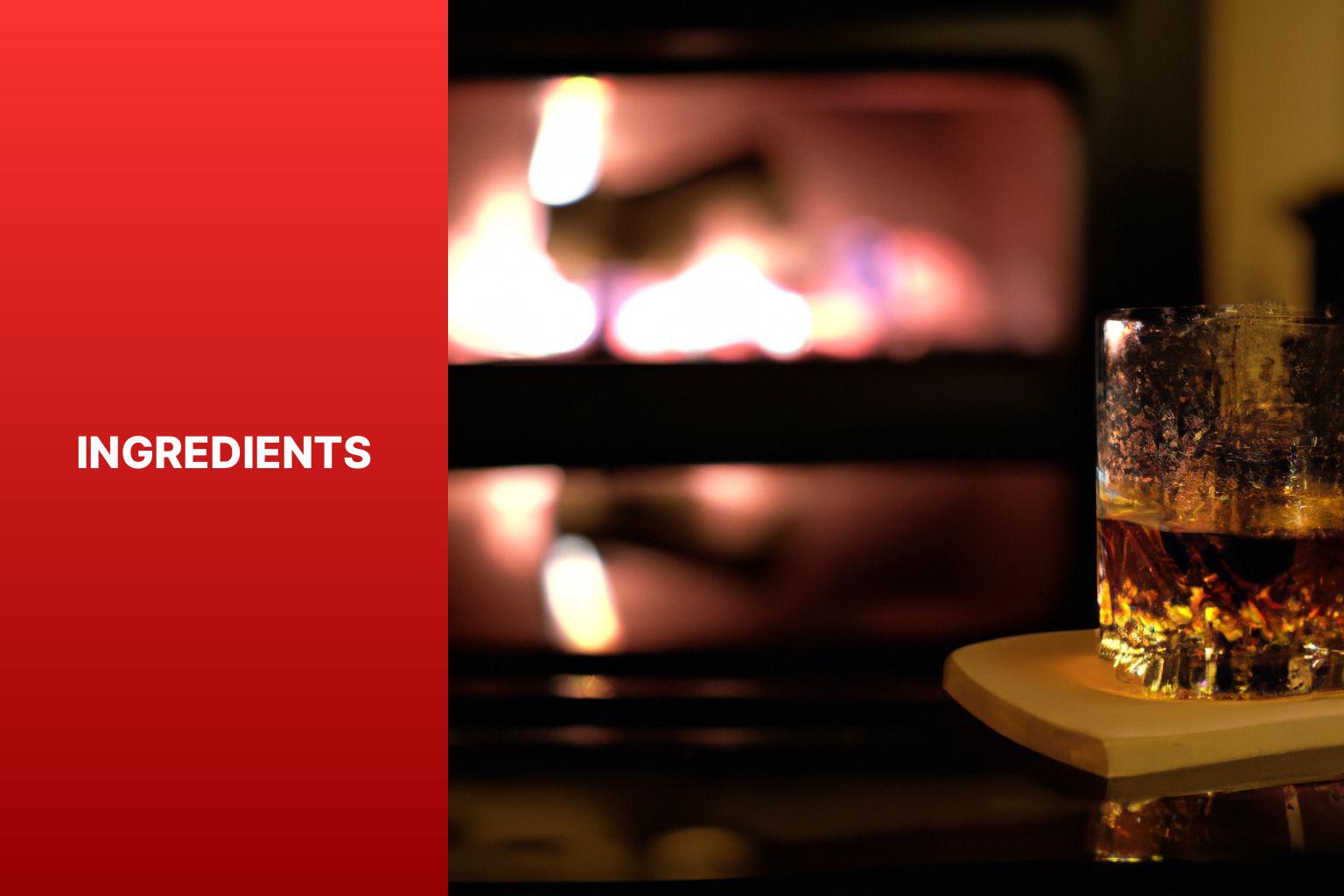
Photo Credits: Www.Moderngentlemanmagazine.Com by Raymond Wilson
Bourbon and Scotch have distinct differences in ingredients. Bourbon is made from at least 51% corn mash, incorporating corn, rye, wheat, or malted barley. On the other hand, Scotch is made exclusively from malted barley, allowing for flavors like peat smoke, malted barley, heather, and dried fruit.
Apart from the ingredients, the country of origin also sets them apart. Bourbon is distilled in the United States, while Scotch is distilled in Scotland. Their aging processes differ as well, with bourbon being aged in new, charred oak barrels and Scotch being aged in used oak barrels. Regarding age requirements, bourbon does not have a specific age requirement, whereas Scotch must be aged in oak barrels for a minimum of three years.
The flavors of bourbon and Scotch are also distinct. Bourbon can have flavors like caramel, vanilla, oak, and corn, while Scotch offers notes of peat smoke, malted barley, heather, and dried fruit.
There are regulations on the proof of the whiskey. Bourbon must have a proof no higher than 160 (80% alcohol by volume), while Scotch must have a proof no higher than 190 (95% alcohol by volume).
Considering these differences in ingredients, it is clear that bourbon and Scotch have their own unique characteristics that contribute to their distinct flavors and profiles.
What Grains are Used in Bourbon?
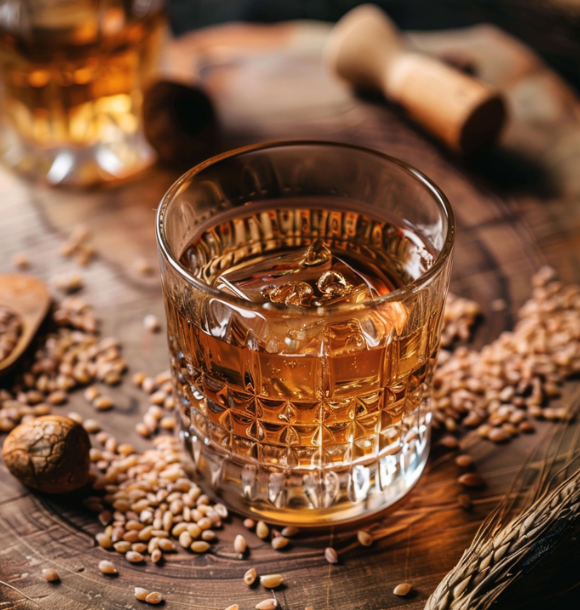
The primary grains used in bourbon, which is a type of whiskey, are corn, rye, and malted barley.
Bourbon must contain at least 51% corn, which is what gives it its sweet and rich flavor.
Rye is added to give the bourbon a spicy and slightly fruity taste, usually making up around 10-15% of the grain mixture.
Malted barley is used in smaller amounts and plays a crucial role in fermentation by converting starches into sugars.
It’s important to note that the ratios of these grains may vary between different brands of bourbon, resulting in a variety of unique flavors.
So, if you ever wondered, “What grains are used in bourbon?” – the answer is corn, rye, and malted barley.
What Grains are Used in Scotch?
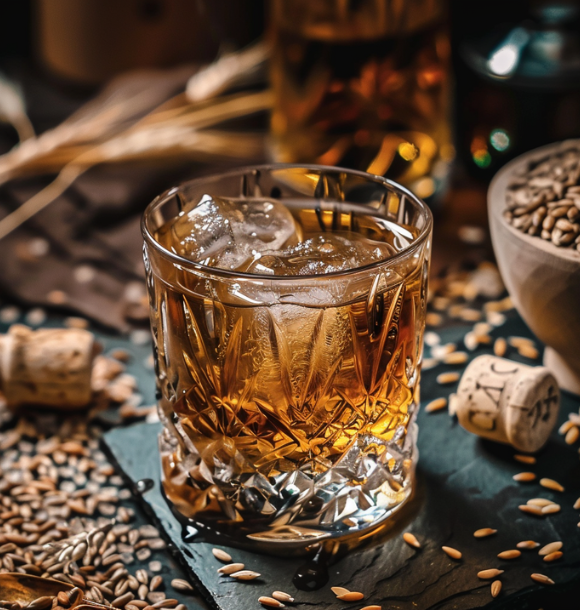
The primary grains used in Scotch production are barley, corn, rye, and wheat.
Barley, specifically malted barley, is utilized before being incorporated into the production process.
This malting process gives barley the necessary enzymes for fermentation and contributes to the distinctive flavor and character that is associated with Scotch whisky.
Additionally, corn is added in smaller quantities to enhance sweetness and body, particularly in blended Scotch whiskies.
Rye and wheat are sporadically employed in order to introduce spiciness and complexity, or smoothness and mellowness respectively.
It is crucial to acknowledge that the production of Scotch is governed by legal regulations.
As per these regulations, the utilization of malted barley or a combination of malted barley and other whole grains is required.
The usage of any other grains is strictly monitored and regulated.
Geographical Origins
When comparing bourbon and scotch, it is important to consider their geographical origins. Bourbon is primarily produced in the United States, with the majority coming from Kentucky. Scotch, on the other hand, is exclusively produced in Scotland, following strict regulations set by the Scotch Whisky Association.
To be considered bourbon, the whiskey must be made in the U.S. and aged in new charred oak barrels. In contrast, Scotch whisky must be aged in oak casks for a minimum of three years as dictated by Scottish law.
Kentucky is known for its limestone-filtered water, which gives bourbon unique mineral characteristics. Meanwhile, Scotland‘s cool and damp climate contributes to the distinct flavors found in Scotch whisky.
Popular bourbon brands include Maker’s Mark, Jim Beam, and Wild Turkey. Well-known scotch brands include Glenfiddich, Macallan, and Laphroaig.
Understanding the geographical origins of bourbon and scotch allows consumers to appreciate the regional influences on these beloved spirits and make informed choices when selecting a whiskey to enjoy.
Where is Bourbon Produced?
Bourbon is primarily produced in the United States, specifically in Kentucky. Kentucky’s hot summers and cold winters create ideal conditions for aging bourbon in oak barrels, allowing it to develop a distinct flavor. The limestone-rich water in the region also adds to the balanced and flavorful spirit.
Although other states like Tennessee, Indiana, and Texas also produce bourbon, Kentucky remains the center of bourbon production with a long tradition and expertise. When selecting bourbon, it’s worth considering the geographical origin and asking the question, “Where is bourbon produced?” Kentucky bourbons are known for their rich flavors, smoothness, and unique combination of climate, water, and distilling traditions. Bourbons from other states also offer distinct characteristics and flavors, providing a variety of options for enthusiasts.
Where is Scotch Produced?

Scotch is a renowned spirit that is exclusively produced in Scotland. It has a legally protected designation and can only be called Scotch if it is made in Scotland according to the Scotch Whisky Regulations of 2009. These regulations meticulously outline the necessary criteria and processes for the production of Scotch.
A crucial requirement for Scotch is that it must be both distilled and matured in oak casks within Scotland for a minimum of three years. Scotland is home to distinct regions that yield various styles of Scotch, each with its own exceptional characteristics and flavors.
The primary regions for Scotch production include:
- Highland: This region boasts a diverse range of Scotch, from delicate and floral to rich and full-bodied. The Highland region is renowned for its esteemed distilleries such as Glenmorangie and Dalmore.
- Speyside: Recognized for having the highest concentration of distilleries in Scotland, Speyside is famous for producing fruity and rich Scotch. Glenfiddich and Macallan are prominent distilleries in this region.
- Islay: Islay is celebrated for its peaty and smoky Scotch, characterized by distinct flavors of smoke, seaweed, and brine. Laphroaig and Ardbeg, both located on Islay, produce Scotch with a uniquely smoky profile.
- Lowland: The Lowland region is renowned for crafting a lighter and more delicate style of Scotch, with notes of floral and grassy flavors. Well-known Lowland distilleries include Auchentoshan and Glenkinchie.
- Campbeltown: Formerly the whisky capital of Scotland, Campbeltown now accommodates only a few distilleries. However, Scotch from this region is highly regarded for its complex and robust flavors. One notable distillery in Campbeltown is Springbank.
Each of these regions possesses its own terroir and distinct production practices, which contribute to the unmistakable characteristics of Scotch. Whether you have a preference for the light and delicate Lowland Scotch or the peaty and smoky Islay Scotch, Scotland’s diverse regions offer a wide array of flavors to explore.
Taste and Flavor Profile
The taste and flavor profiles of bourbon and Scotch differ. Here is a comparison table that highlights key differences:
| Aspect | Bourbon | Scotch |
| Aroma | Bourbon has a rich and sweet aroma with notes of caramel, vanilla, and oak. | Scotch has a diverse range of aromas, including peat smoke, heather, honey, and fruits. |
| Taste | Bourbon has a sweeter taste profile, with flavors of corn, caramel, and brown sugar. It can also have hints of spice and oak. | Scotch’s taste can vary depending on the region, but some common flavors include peat smoke, malt, honey, fruit, and a touch of brine. |
| Finish | The finish of bourbon is warm and smooth, with lingering flavors of vanilla and caramel. | Scotch may have a longer and more complex finish, with smoky, fruity, or malty notes lingering on the palate. |
| Production | Bourbon is primarily made in the United States and is aged in new, charred oak barrels. | Scotch is made in Scotland and is aged in used oak barrels, which can impart different flavors and characteristics. |
| Legal Definition | To be called bourbon, the spirit must meet specific criteria, including being made from a grain mixture that is at least 51% corn and aged in new charred oak barrels. | Scotch must be made in Scotland and aged in oak barrels for a minimum of three years. |
Note that individual brands within each category may have variations in taste and flavor profiles. It is recommended to explore different brands and expressions to fully appreciate the diversity within bourbon and Scotch.
What are the Characteristics of Bourbon?
| Characteristics of Bourbon |
| 1. Ingredients: Bourbon is primarily made from corn, with at least 51% corn content. It also includes other grains like barley, rye, and wheat, which contribute to its unique flavor. |
| 2. Aging Process: Bourbon must age in new charred oak barrels. This process gives bourbon its rich amber color and imparts flavors from the wood such as vanilla, caramel, and oak. |
| 3. Distinct Flavor Profile: Bourbon is known for its smooth and sweet taste. It has notes of caramel, vanilla, butterscotch, and a hint of spiciness from the rye. The high corn content adds sweetness. |
| 4. Minimum Aging Requirement: To be straight bourbon, it must age for at least two years. Premium bourbons often age longer, developing more complex flavors. |
| 5. Geographical Origins: Bourbon is closely associated with the United States, particularly Kentucky. While it can be made anywhere in the country, Kentucky bourbon is considered the most famous and prestigious. |
| 6. Quality Control: Bourbon production is highly regulated, ensuring it meets specific standards. This includes guidelines for distillation proof, bottling strength, and labeling requirements. |
| 7. Drinking Culture: Bourbon has a rich history and is often associated with American tradition and Southern hospitality. It is enjoyed neat, on the rocks, or in classic cocktails like the Old Fashioned and the Mint Julep. |
When exploring the characteristics of bourbon, it is important to consider its ingredients, aging process, distinct flavor profile, minimum aging requirement, geographical origins, quality control, and drinking culture. Bourbon is made primarily from corn, with other grains like barley, rye, and wheat contributing to its flavor. It must age in new charred oak barrels, giving it a rich amber color and flavors from the wood. Bourbon is known for its smooth and sweet taste, notes of caramel, vanilla, butterscotch, and a hint of spiciness from the rye. To be considered straight bourbon, it must age for at least two years. Kentucky bourbon is the most famous and prestigious, although it can be made anywhere in the United States. Bourbon production is regulated to ensure it meets specific standards. Bourbon has a rich history and is often enjoyed neat, on the rocks, or in classic cocktails.
What are the Characteristics of Scotch?
The characteristics of Scotch include its distinctive flavor profile. Scotch is known for its complex and rich flavor profile, offering a balance of smokiness, sweetness, and earthiness. These characteristics can vary based on factors such as production region and aging. Scotch is also defined by its peatiness, which comes from using peat smoke to dry malted barley, giving it a distinct smoky flavor.
Scotch is aged for a minimum of three years in oak barrels, enhancing its flavors and smoothness. Older Scotch whiskies have more depth and complexity. Regional variations are also seen in Scotch whisky, with different regions having unique characteristics. For example, Islay whiskies are intensely smoky, while Speyside whiskies are fruity and floral.
Strict production regulations ensure the quality and authenticity of Scotch whisky. It must be made in Scotland, using malted barley and pot still distillation. Lastly, Scotch whisky is deeply ingrained in Scottish culture, with a rich history and a strong appreciation for tradition and craftsmanship in both production and enjoyment.
Drinking Culture and Traditions
Drinking culture and traditions are integral to the consumption of bourbon and Scotch. These spirits have a rich history and heritage, with bourbon dating back to the 18th century in America and Scotch being crafted in Scotland for centuries. The production processes of these drinks also contribute to their distinct flavors. Bourbon, made from corn and aged in new charred oak barrels, offers a rich and sweet taste. On the other hand, Scotch, often crafted from malted barley and aged in used oak barrels, presents a diverse range of flavors.
Both bourbon and Scotch have unique tasting rituals. With bourbon, one sniffs the aromas, takes small sips, and allows the flavors to unfold. Scotch tasting, however, varies depending on the region and style but typically involves appreciating complex flavors using different types of glasses.
When it comes to pairing these spirits with food, bourbon complements Southern dishes and desserts with its sweet and caramel notes. On the other hand, Scotch pairs well with seafood, smoked meats, and cheese due to its wide range of flavor profiles.
Understanding the social significance of these spirits is important. Bourbon is often associated with American whiskey bars and gatherings, while Scotch is enjoyed at formal occasions, ceremonies, or Scotch tastings.
By delving into the drinking culture and traditions surrounding bourbon and Scotch, individuals can develop a deeper appreciation for these spirits and establish a stronger connection to their historical and cultural roots.
How is Bourbon Traditionally Enjoyed?
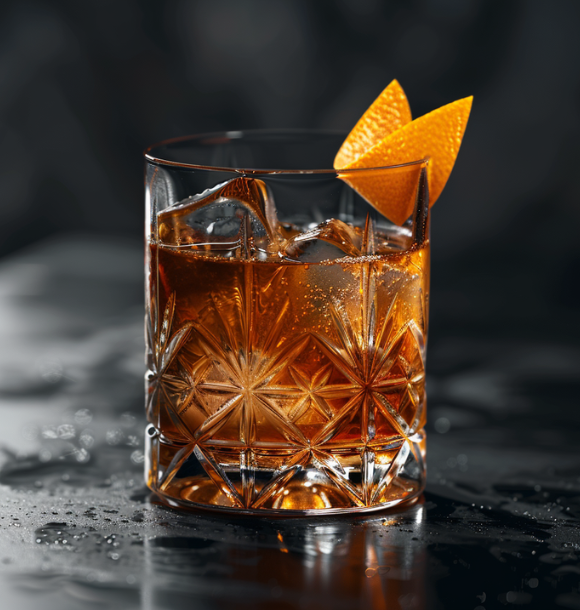
Bourbon is traditionally enjoyed neat or on the rocks. Some enthusiasts add water to enhance the flavors and aromas. It can also be enjoyed in classic cocktails like the Old Fashioned or Manhattan. For a refreshing twist, mix bourbon with ginger ale or cola. During social gatherings, bourbon can be shared with friends. Pair it with rich-flavored dishes like grilled meats or dark chocolate. Some enthusiasts experiment with infused flavors. Tastings and distillery visits offer a chance to learn about production and history while guided.
How is Scotch Traditionally Enjoyed?
Scotch whisky is traditionally enjoyed in a few ways, each enhancing the flavors of the spirit. Here are some traditional methods:
1. Neat: Drink Scotch without dilution or mixers to savor its complexity and appreciate its flavors and aromas.
2. On the rocks: Add ice cubes to slightly chill and dilute the whisky, mellowing out flavors for a less intense experience.
3. With a splash of water: Adding water opens up flavors and aromas, reducing alcohol burn and allowing full enjoyment of the whisky’s complexity.
4. Whisky tasting events: Participate in events or visit distilleries to experience Scotch in its traditional setting. Learn about the whisky-making process, sample different expressions, and gain a deeper understanding of the history and culture surrounding Scotch.
5. Whisky cocktails: Use Scotch as a base spirit in cocktails, such as the Rob Roy and the Rusty Nail.
It’s important to note that personal preferences vary, and there is no right or wrong way to enjoy Scotch. Experiment and find the method that best suits your taste and enhances your appreciation for this fine spirit. Whether neat, on the rocks, with water, or in a cocktail, the enjoyment of Scotch is a personal journey.
Price and Accessibility
When comparing bourbon and Scotch, price and accessibility are important factors. Bourbon tends to be more affordable compared to Scotch. On average, a bottle of bourbon can range from $20 to $60, depending on the brand and quality. This makes bourbon a popular budget-friendly option. In contrast, Scotch is generally more expensive than bourbon. Prices for a bottle of Scotch can start around $30 and go up to several hundred or even thousands of dollars for rare or aged expressions. The cost of Scotch is influenced by factors such as the region, distillery, age, and rarity of the whisky.
In terms of accessibility, bourbon is more widely available and accessible. It can be found in most liquor stores, supermarkets, and online retailers. The popularity of bourbon has led to a wide distribution, making it easier to find and purchase. On the other hand, Scotch may not be as easily accessible as bourbon. Certain regions or specific Scotch brands may have limited availability. Rare or limited-edition Scotch whiskies might require more effort to track down and may only be found in specialty stores or through online retailers.
Considering price and accessibility is crucial in selecting between bourbon and Scotch, as it helps determine the affordability and convenience of enjoying these renowned spirits.
Is Bourbon More Affordable than Scotch?
Bourbon is generally more affordable than Scotch. Bourbon tends to be more budget-friendly compared to Scotch. Scotch is often seen as a premium spirit and can be more expensive than Bourbon. Factors such as production process, geographical origins, and brand and rarity influence the price difference between Bourbon and Scotch.
Bourbon is aged for a minimum of two years in new charred oak barrels, while Scotch whisky is aged for at least three years in used oak barrels. The cost of new barrels used in Bourbon production can be lower compared to the used barrels for Scotch. Scotch whisky is mainly produced in Scotland, where the climate and production regulations can lead to higher costs. Bourbon is primarily made in the United States, where production costs may be comparatively lower.
Some Scotch brands are exclusive and have limited production, which increases their prices. Bourbon brands may vary in pricing based on popularity and availability.
Is Scotch More Accessible than Bourbon?

Scotch whisky is indeed more accessible than bourbon in terms of availability and distribution.
The production of Scotch whisky is spread out across various regions in Scotland, which allows for a wider distribution reach.
Established whisky companies, with their extensive networks and partnerships, play a significant role in the distribution of Scotch whiskies, ensuring that they reach a larger consumer base.
These companies heavily invest in marketing campaigns and establish strong relationships with retailers to ensure the availability of Scotch whiskies in numerous locations.
On the other hand, bourbon is primarily produced in Kentucky, which limits its distribution compared to Scotch.
Some smaller bourbon distilleries may have a more localized distribution network, which in turn limits their availability in certain regions.
The regulations surrounding bourbon production, such as the use of specific grains and aging requirements, may also contribute to the limited number of bourbon producers compared to Scotch whisky producers.
All these factors combined make Scotch more accessible than bourbon.
Frequently Asked Questions
What is the significance of July 24, 2023, in relation to the bourbon vs scotch debate?
July 24, 2023, marks the release of top new cigars, which signifies the surge of new cigar releases in the summer season. While this date may not have a direct impact on the bourbon vs scotch debate, it shows that the market for distilled spirits, including bourbon and scotch, is heating up and evolving with new offerings.
What are the production standards for bourbon and scotch?
Bourbon must be made in the United States and contain at least 51% corn in its mash recipe. Scotch, on the other hand, can only be made in Scotland and typically uses malted barley as its primary grain. These production standards distinguish bourbon and scotch and contribute to their unique characteristics and flavor profiles.
What is the difference between whiskey and whisky, and how does it relate to bourbon and scotch?
The spelling difference between whiskey and whisky is primarily a regional variation. American distillers, including bourbon producers, typically use the ‘ey’ spelling (whiskey), while Scottish distillers, including scotch producers, use the ‘y’ spelling (whisky). Bourbon is a type of American whiskey, while Scotch is a type of Scottish whisky. This distinction is important when discussing the bourbon vs scotch debate.
What are the key factors to consider when comparing bourbon and scotch?
When comparing bourbon and scotch, several factors come into play. These include the production standards, such as the country of origin and mash recipe, the aging process and maturation requirements, the flavor profiles and characteristics, and personal preferences in terms of taste and experience. These factors influence the market differentiation and appeal of bourbon and scotch to different consumers.
Are there any notable brands or specific products associated with the bourbon vs scotch debate?
Yes, there are several well-known brands associated with the bourbon and scotch categories. Examples include Jack Daniel’s Tennessee Whiskey, Jameson Irish Whiskey, Highland Park Scotch Whisky, and Johnnie Walker Scotch Whisky. Each brand offers its own unique range of products, contributing to the comparative analysis and discussion within the bourbon vs scotch debate.
How long does it take to read the article about the top new cigars released on July 24, 2023?
The estimated reading time for the article is 3 minutes. This timeframe provides an idea of the article’s length and can help individuals allocate their time accordingly when seeking information about the latest cigars from Drew Estate, Diesel, and Dunbarton Tobacco & Trust.
